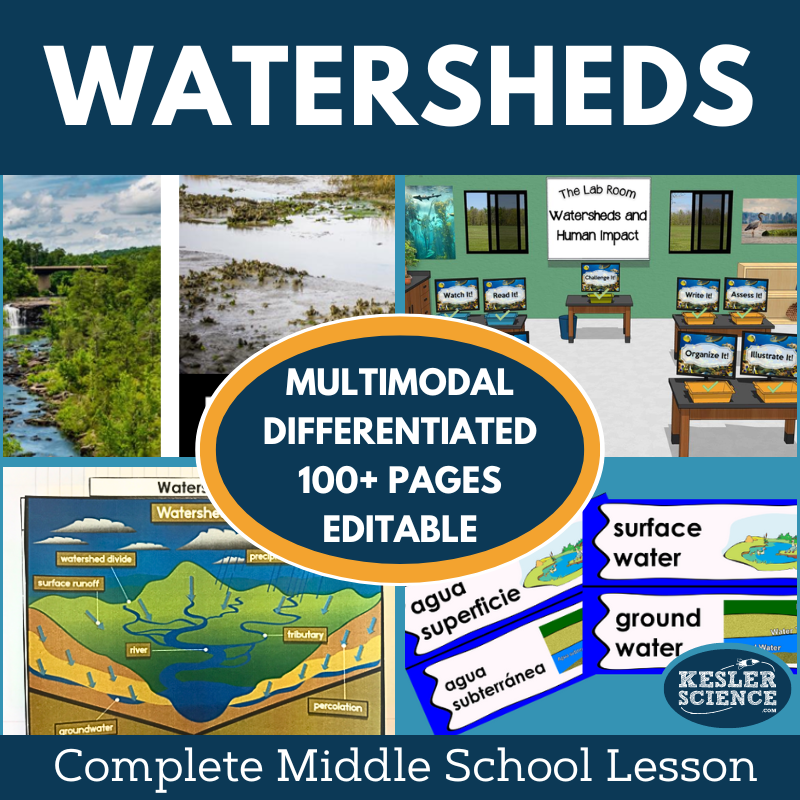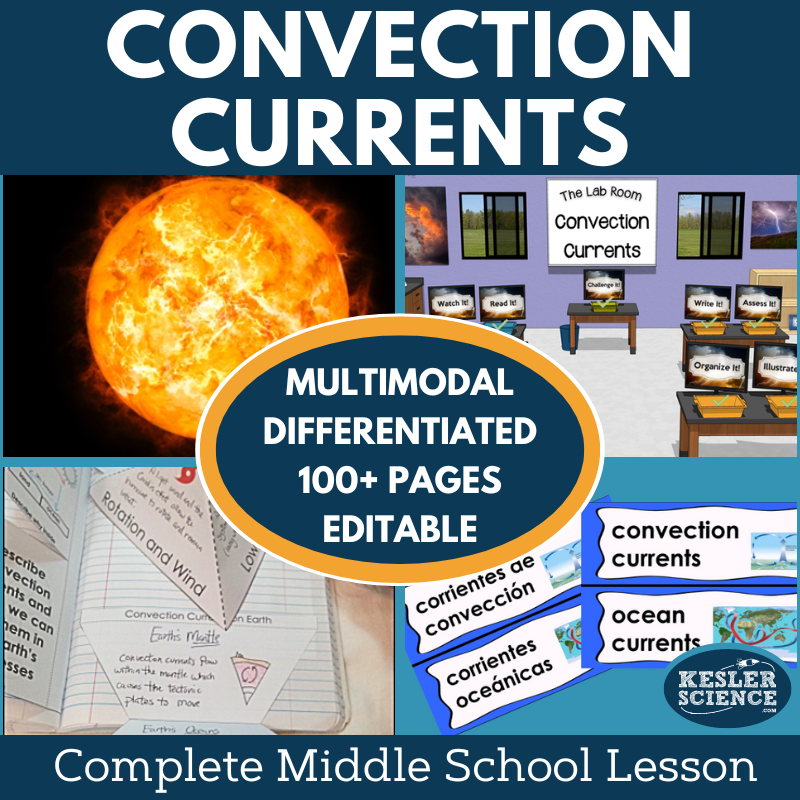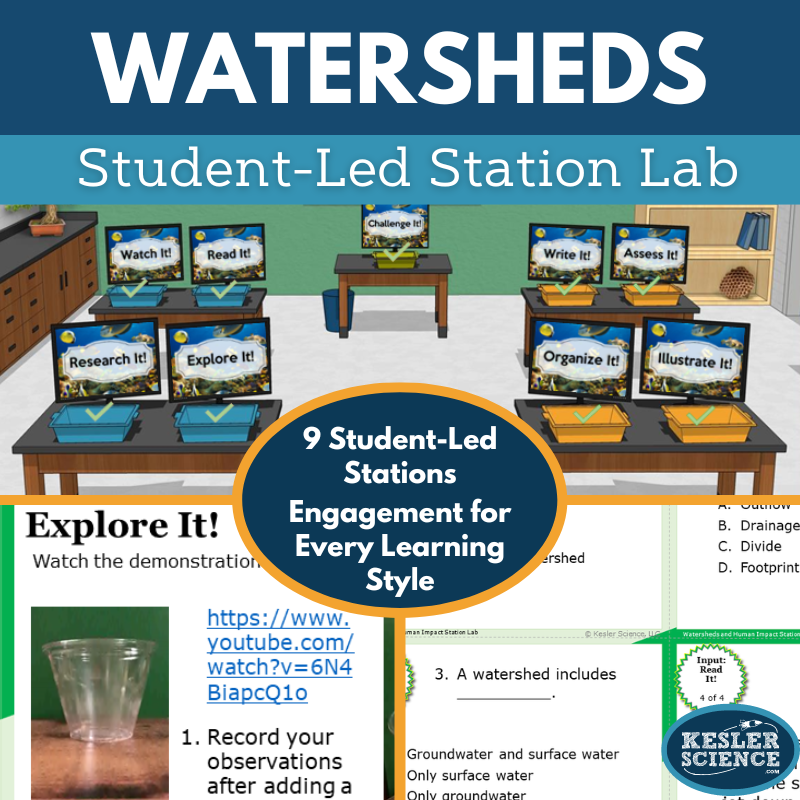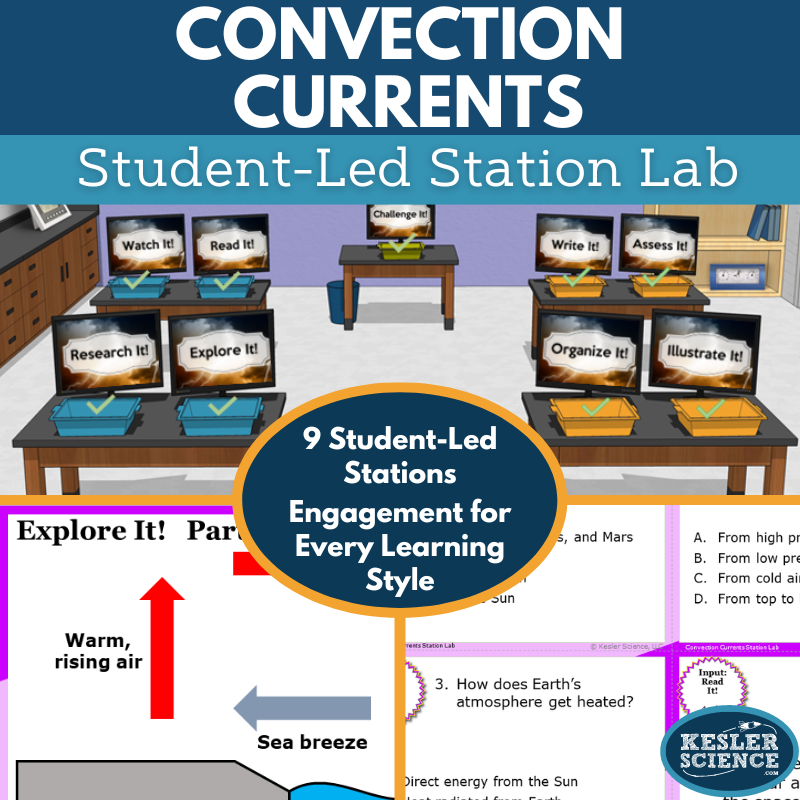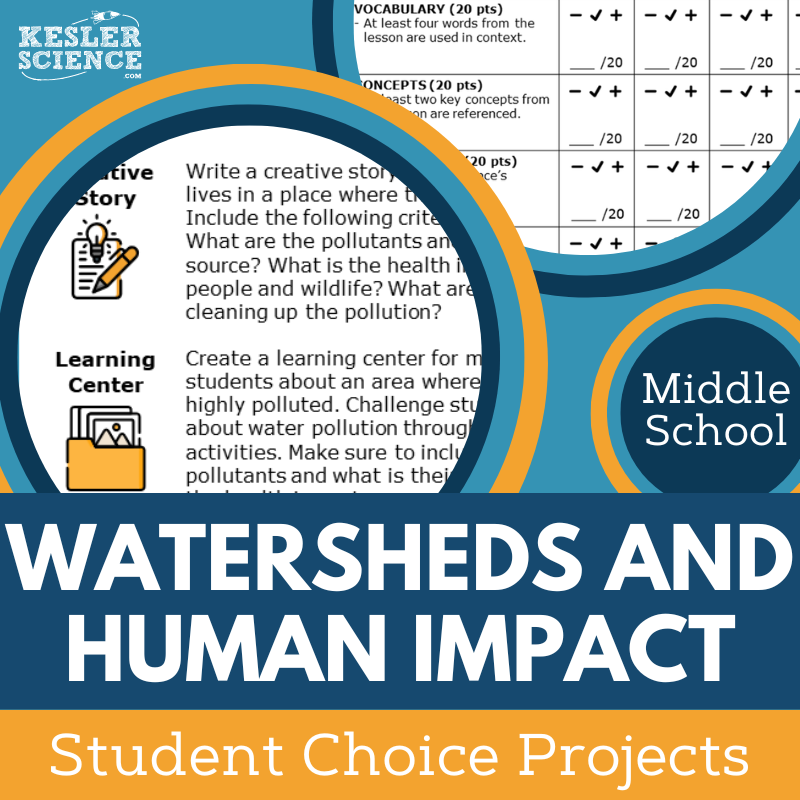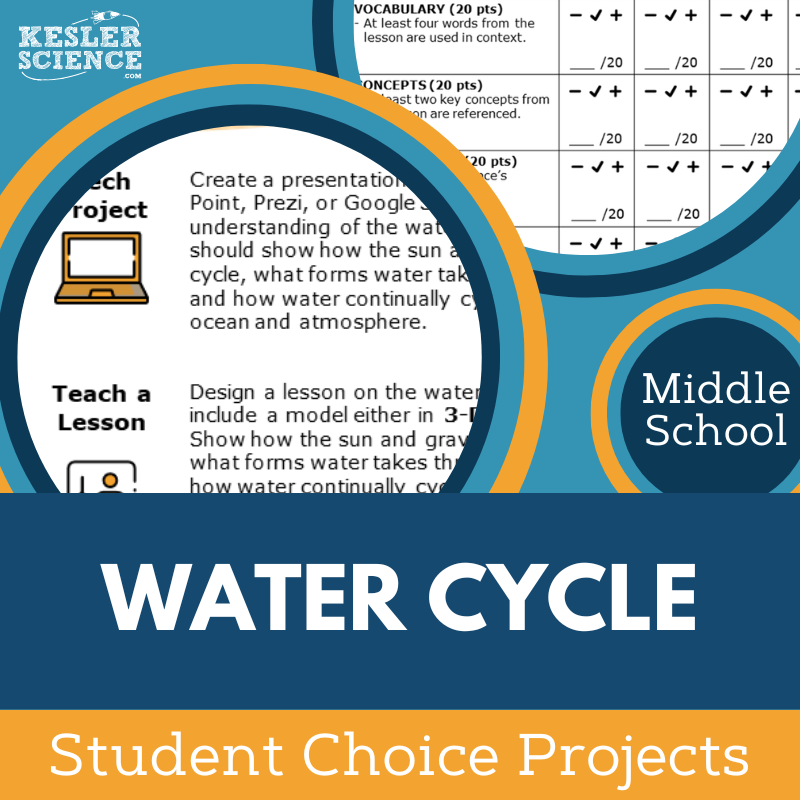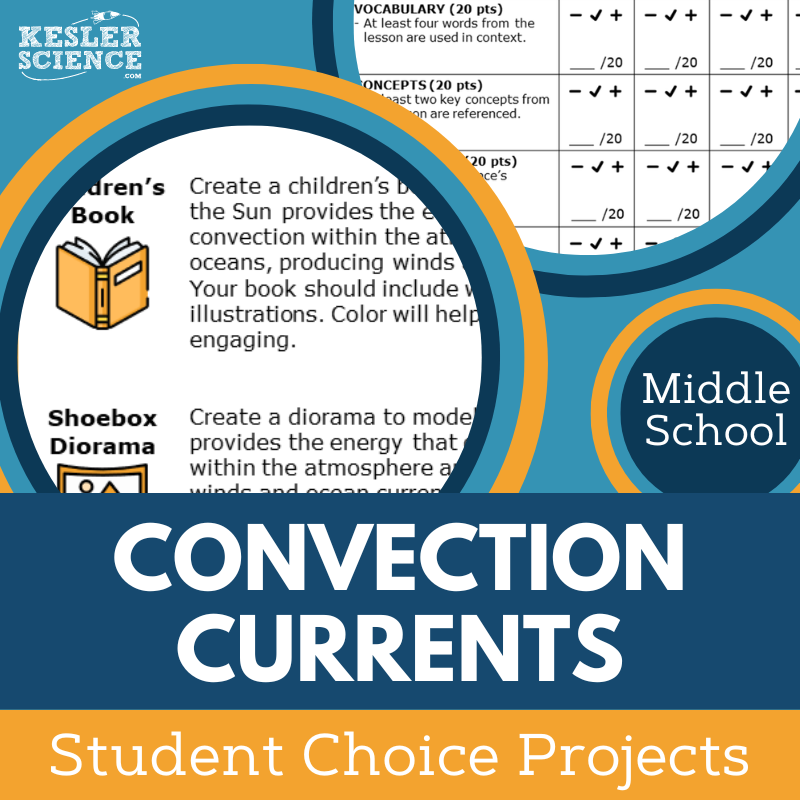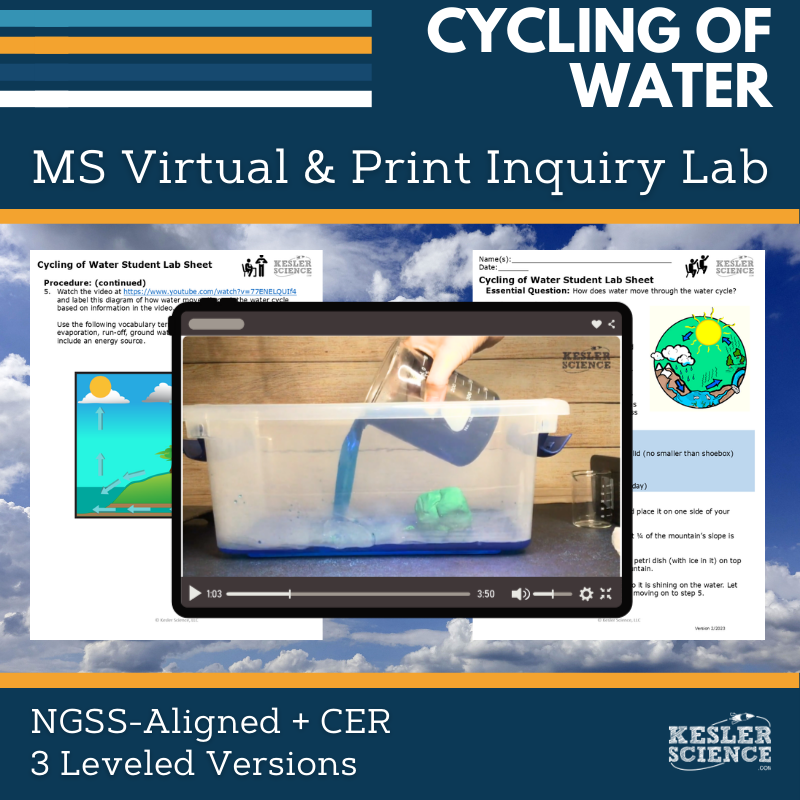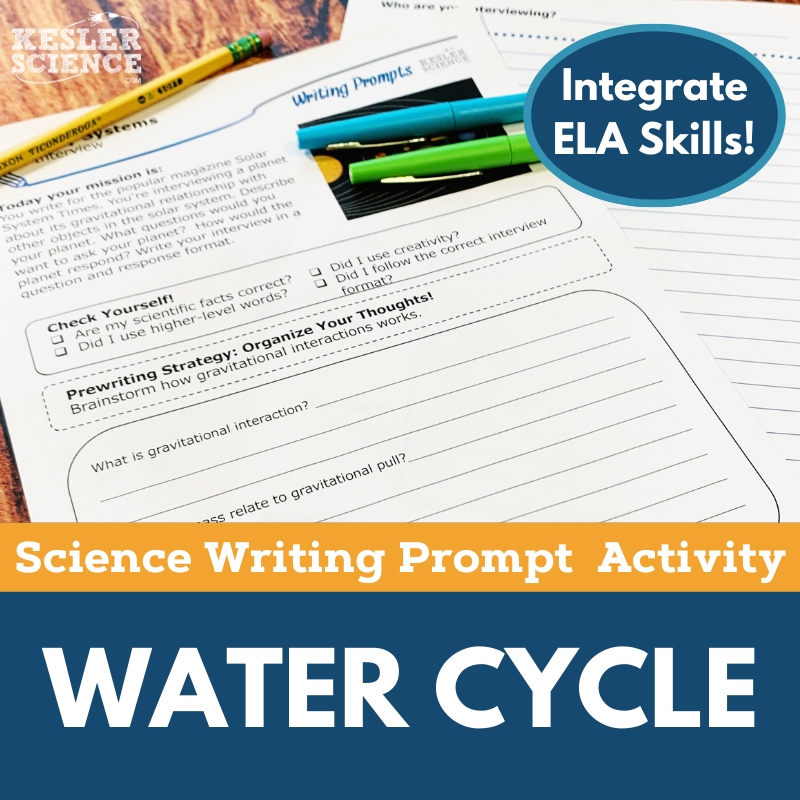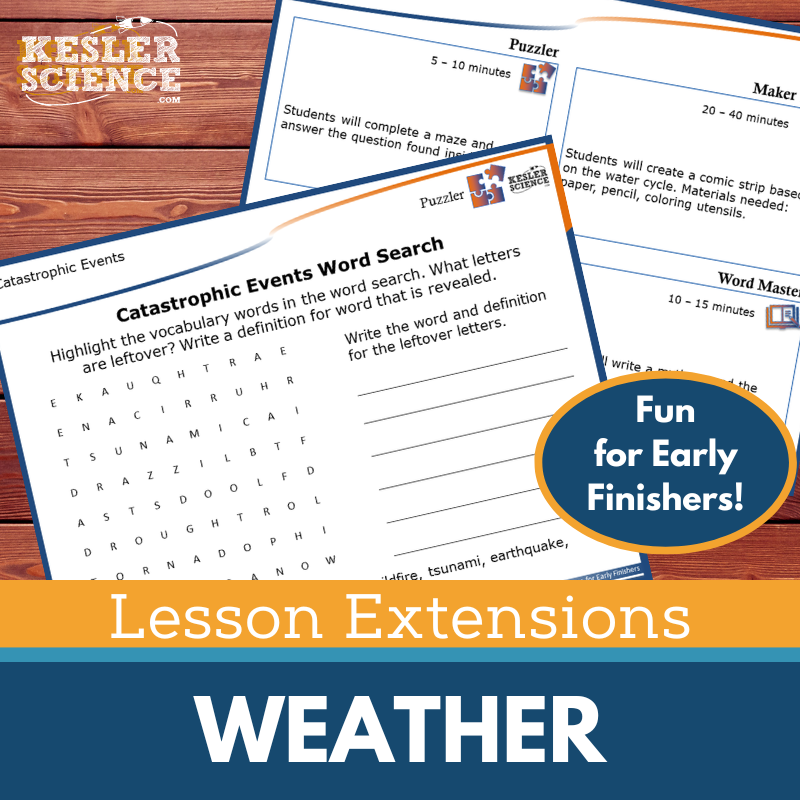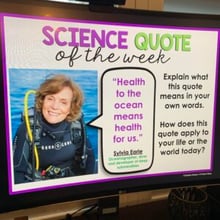Cycling of Water Activities for Middle School Science
The Kesler Science Watersheds, Water Cycle, and Convection Currents 5E Lessons provide comprehensive, student-led learning experiences for middle school classrooms, focusing on key earth science concepts. Using the 5E Model, students explore watersheds, including fresh and saltwater differences, groundwater, aquifers, pollution, and conservation, as well as the water cycle’s movement through land, oceans, and the atmosphere, driven by the Sun and gravity. The resources below will give students a comprehensive understanding of the cycling of water. All of the following materials are also included in the Kesler Science Membership.
The Kesler Science Watersheds 5E Lesson is a comprehensive, student-led unit designed for middle school classrooms. It includes editable presentations, worksheets, assessments, and choice projects, all structured for differentiated, multimodal learning with minimal prep. The lesson aligns with NGSS standards and follows the 5E Model: Engagement, Exploration, Explanation, Elaboration, and Evaluation.
Students explore key concepts such as the differences between fresh and saltwater, surface and groundwater examples, aquifer components, water pollution types, and conservation methods. The hands-on station lab provides multiple ways to engage with the content, including experiments, reading passages, research tasks, videos, card sorts, writing prompts, and creative activities. Editable PowerPoints and interactive notebooks in English and Spanish support instruction, while student-choice projects extend learning. Assessments include STAAR 2.0-aligned questions, review worksheets, and differentiated evaluation options.
This resource is flexible for in-person or virtual learning, with digital and printable formats available. Spanish translations of vocabulary, reading passages, and interactive notebook pages enhance accessibility. The lesson ensures engagement while allowing teachers to focus on student success.
The Kesler Science Watersheds 5E Lesson is a comprehensive, student-led unit designed for middle school classrooms. It includes editable presentations, worksheets, assessments, and choice projects, all structured for differentiated, multimodal learning with minimal prep. The lesson aligns with NGSS standards and follows the 5E Model: Engagement, Exploration, Explanation, Elaboration, and Evaluation.
Students explore key concepts such as the differences between fresh and saltwater, surface and groundwater examples, aquifer components, water pollution types, and conservation methods. The hands-on station lab provides multiple ways to engage with the content, including experiments, reading passages, research tasks, videos, card sorts, writing prompts, and creative activities. Editable PowerPoints and interactive notebooks in English and Spanish support instruction, while student-choice projects extend learning. Assessments include STAAR 2.0-aligned questions, review worksheets, and differentiated evaluation options.
This resource is flexible for in-person or virtual learning, with digital and printable formats available. Spanish translations of vocabulary, reading passages, and interactive notebook pages enhance accessibility. The lesson ensures engagement while allowing teachers to focus on student success.
The Kesler Science Water Cycle 5E Lesson is a comprehensive, student-led unit designed for middle school learners. It includes editable presentations, worksheets, choice projects, and assessments, all requiring minimal prep. The lesson explores how water cycles through land, oceans, and the atmosphere, its various forms, and the roles of the Sun and gravity in the process.
The unit follows the 5E Model, integrating differentiated, multimodal learning. Engagement activities include objectives, word wall cards, and interactive class discussions. Exploration features a hands-on, student-led station lab with nine stations, incorporating reading, research, video analysis, hands-on experiments, and creative expression. Explanation provides editable PowerPoints, interactive notebooks in English and Spanish, and structured note-taking templates. Elaboration allows students to extend learning through choice projects, while Evaluation includes STAAR 2.0-aligned assessments, discussion questions, and practice worksheets.
This resource is available in both print and digital formats, with Spanish translations of key materials. It is fully adaptable for virtual learning, ensuring flexibility in any instructional setting.
The Kesler Science Water Cycle 5E Lesson is a comprehensive, student-led unit designed for middle school learners. It includes editable presentations, worksheets, choice projects, and assessments, all requiring minimal prep. The lesson explores how water cycles through land, oceans, and the atmosphere, its various forms, and the roles of the Sun and gravity in the process.
The unit follows the 5E Model, integrating differentiated, multimodal learning. Engagement activities include objectives, word wall cards, and interactive class discussions. Exploration features a hands-on, student-led station lab with nine stations, incorporating reading, research, video analysis, hands-on experiments, and creative expression. Explanation provides editable PowerPoints, interactive notebooks in English and Spanish, and structured note-taking templates. Elaboration allows students to extend learning through choice projects, while Evaluation includes STAAR 2.0-aligned assessments, discussion questions, and practice worksheets.
This resource is available in both print and digital formats, with Spanish translations of key materials. It is fully adaptable for virtual learning, ensuring flexibility in any instructional setting.
The Kesler Science Convection Currents 5E Lesson is a comprehensive middle school unit exploring how the Sun’s energy drives convection within the atmosphere and oceans, producing winds and ocean currents. This fully editable, student-led lesson includes presentations, worksheets, choice projects, and assessments, requiring minimal prep while promoting differentiated learning.
Following the 5E Model, the lesson engages students with vocabulary cards and class discussions, then guides them through a student-led station lab with nine differentiated exploration stations. These stations include hands-on experiments, reading passages in English and Spanish, research tasks, videos, and various output activities like writing, illustrating, and assessments. A bonus station offers extension activities for early finishers.
The explanation phase features editable PowerPoints, interactive notebooks, and note-taking templates. Students extend their learning through choice projects, while evaluation includes STAAR 2.0-aligned assessments, review questions, and worksheets.
Designed for maximum flexibility, this resource includes printable and digital formats with Spanish translations of key materials. It is fully adaptable for both classroom and virtual learning, ensuring accessibility and engagement for all students.
The Kesler Science Convection Currents 5E Lesson is a comprehensive middle school unit exploring how the Sun’s energy drives convection within the atmosphere and oceans, producing winds and ocean currents. This fully editable, student-led lesson includes presentations, worksheets, choice projects, and assessments, requiring minimal prep while promoting differentiated learning.
Following the 5E Model, the lesson engages students with vocabulary cards and class discussions, then guides them through a student-led station lab with nine differentiated exploration stations. These stations include hands-on experiments, reading passages in English and Spanish, research tasks, videos, and various output activities like writing, illustrating, and assessments. A bonus station offers extension activities for early finishers.
The explanation phase features editable PowerPoints, interactive notebooks, and note-taking templates. Students extend their learning through choice projects, while evaluation includes STAAR 2.0-aligned assessments, review questions, and worksheets.
Designed for maximum flexibility, this resource includes printable and digital formats with Spanish translations of key materials. It is fully adaptable for both classroom and virtual learning, ensuring accessibility and engagement for all students.
Engage your middle school students with this student-led station lab on watersheds. Designed for in-class or virtual learning, this modular lesson allows students to explore watershed characteristics through nine interactive stations featuring videos, readings, research, and hands-on tasks.
Students demonstrate their understanding by organizing information, illustrating models, writing responses, and completing assessments. A challenge station offers extension activities for early finishers, and differentiated reading passages in English and Spanish support diverse learners.
This low-prep, high-engagement resource promotes active learning and critical thinking while allowing students to direct their own learning experience.
Engage your middle school students with this student-led station lab on watersheds. Designed for in-class or virtual learning, this modular lesson allows students to explore watershed characteristics through nine interactive stations featuring videos, readings, research, and hands-on tasks.
Students demonstrate their understanding by organizing information, illustrating models, writing responses, and completing assessments. A challenge station offers extension activities for early finishers, and differentiated reading passages in English and Spanish support diverse learners.
This low-prep, high-engagement resource promotes active learning and critical thinking while allowing students to direct their own learning experience.
Engage your middle school students with this student-led Water Cycle Station Lab, designed for active learning and minimal teacher prep. This hands-on lesson guides students to explore how water cycles through land, ocean, and atmosphere, the forms water takes, and the role of the Sun and gravity in the process.
Students engage with nine differentiated stations that offer multimodal learning experiences, including hands-on experiments, research, reading comprehension, videos, and interactive activities. They demonstrate understanding by organizing information, illustrating models, writing responses, and completing assessments. A challenge station provides extension activities for advanced learners.
This flexible resource includes all necessary signage, literature, resources, and task cards for independent or small-group learning. Available in both English and Spanish, it supports in-class and virtual learning, making science accessible and engaging for all students.
Engage your middle school students with this student-led Water Cycle Station Lab, designed for active learning and minimal teacher prep. This hands-on lesson guides students to explore how water cycles through land, ocean, and atmosphere, the forms water takes, and the role of the sun and gravity in the process.
Students engage with nine differentiated stations that offer multimodal learning experiences, including hands-on experiments, research, reading comprehension, videos, and interactive activities. They demonstrate understanding by organizing information, illustrating models, writing responses, and completing assessments. A challenge station provides extension activities for advanced learners.
This flexible resource includes all necessary signage, literature, resources, and task cards for independent or small-group learning. Available in both English and Spanish, it supports in-class and virtual learning, making science accessible and engaging for all students.
Engage your students with this student-led Convection Currents Station Lab, designed for hands-on and interactive learning in Earth science. This low-prep, modular activity allows students to explore how unequal heating and Earth’s rotation drive atmospheric and oceanic circulation, shaping regional climates.
Students work through nine differentiated stations, engaging with content through videos, readings, research, and hands-on demonstrations. They demonstrate their understanding by organizing information, illustrating models, answering questions, and completing assessments. A bonus challenge station offers extension activities for early finishers, and English and Spanish reading passages support differentiated instruction.
This versatile resource is ideal for in-class or virtual learning, promoting critical thinking and independent exploration.
Engage your students with this student-led Convection Currents Station Lab, designed for hands-on and interactive learning in Earth science. This low-prep, modular activity allows students to explore how unequal heating and Earth’s rotation drive atmospheric and oceanic circulation, shaping regional climates.
Students work through nine differentiated stations, engaging with content through videos, readings, research, and hands-on demonstrations. They demonstrate their understanding by organizing information, illustrating models, answering questions, and completing assessments. A bonus challenge station offers extension activities for early finishers, and English and Spanish reading passages support differentiated instruction.
This versatile resource is ideal for in-class or virtual learning, promoting critical thinking and independent exploration.
The Watersheds and Human Impact Student Choice Projects align with NGSS standards, allowing middle school students to select a project that matches their preferred output style. A project page outlines six student-led options plus a “design your own” project, all supported by an editable rubric for teacher, peer, or self-assessment.
These flexible, multimodal projects offer creative ways for students to demonstrate their understanding. Two versions of the project page provide differentiation, with modified options for students needing remediation and challenge opportunities for advanced learners. Teachers can adjust the rubric to fit grading needs.
The projects require standard classroom supplies like paper, markers, and scissors, with many options available for digital completion. Some crafting materials may be helpful for model-building.
The Watersheds and Human Impact Student Choice Projects align with NGSS standards, allowing middle school students to select a project that matches their preferred output style. A project page outlines six student-led options plus a “design your own” project, all supported by an editable rubric for teacher, peer, or self-assessment.
These flexible, multimodal projects offer creative ways for students to demonstrate their understanding. Two versions of the project page provide differentiation, with modified options for students needing remediation and challenge opportunities for advanced learners. Teachers can adjust the rubric to fit grading needs.
The projects require standard classroom supplies like paper, markers, and scissors, with many options available for digital completion. Some crafting materials may be helpful for model-building.
The Water Cycle Student Choice Projects align with NGSS standards, allowing middle school students to demonstrate their understanding through a project that matches their preferred output style. A project page outlines six student-led options plus a “design your own” project, with an editable rubric for teacher, peer, or self-assessment.
These flexible, multimodal projects provide creative ways for students to engage with the material. Two versions of the project page support differentiation, with modified options for students needing remediation and challenge opportunities for advanced learners. Teachers can adjust the rubric to fit their grading needs.
The projects require standard classroom supplies like paper, markers, and scissors, with many options available for digital completion. Some crafting materials may be helpful for model-building projects.
The Water Cycle Student Choice Projects align with NGSS standards, allowing middle school students to demonstrate their understanding through a project that matches their preferred output style. A project page outlines six student-led options plus a “design your own” project, with an editable rubric for teacher, peer, or self-assessment.
These flexible, multimodal projects provide creative ways for students to engage with the material. Two versions of the project page support differentiation, with modified options for students needing remediation and challenge opportunities for advanced learners. Teachers can adjust the rubric to fit their grading needs.
The projects require standard classroom supplies like paper, markers, and scissors, with many options available for digital completion. Some crafting materials may be helpful for model-building projects.
The Convection Currents Student Choice Projects align with NGSS standards, allowing middle school students to select a project that fits their preferred output style. A project page outlines six student-led options plus a “design your own” project, all with an editable rubric for teacher, peer, or self-assessment.
These flexible, multimodal projects provide creative ways for students to demonstrate their understanding. Two versions of the project page support differentiation, with modified options for students needing remediation and challenge options for advanced learners. Teachers can adjust the rubric to fit grading needs.
The projects use standard classroom supplies like paper, markers, and scissors, with many options available for digital completion. Some crafting supplies may be useful for model-building.
The Convection Currents Student Choice Projects align with NGSS standards, allowing middle school students to select a project that fits their preferred output style. A project page outlines six student-led options plus a “design your own” project, all with an editable rubric for teacher, peer, or self-assessment.
These flexible, multimodal projects provide creative ways for students to demonstrate their understanding. Two versions of the project page support differentiation, with modified options for students needing remediation and challenge options for advanced learners. Teachers can adjust the rubric to fit grading needs.
The projects use standard classroom supplies like paper, markers, and scissors, with many options available for digital completion. Some crafting supplies may be useful for model-building.
The Water Cycle Inquiry Lab aligns with NGSS MS-ESS2-4, guiding students to develop a model demonstrating how water moves through Earth’s systems, driven by solar energy and gravity. This lab offers both hands-on and digital versions, making it adaptable for various learning environments.
Students can engage with a virtual demonstration, pre-recorded video, or conduct the experiment themselves using materials like clay, a plastic container, warm water, a Petri dish, ice, and a heat source. The digital version, compatible with Google Slides and major LMS platforms, includes interactive activities and a video walkthrough, ensuring accessibility even without physical materials.
Designed for differentiation, the lab includes three levels: Dependent (guided inquiry), Modified (structured support with simplified questioning), and Independent (student-led exploration). Editable PowerPoints allow customization, and the resource includes teacher guides, answer keys, and Claim-Evidence-Reasoning (C.E.R.) prompts to support student reflection and comprehension.
The Water Cycle Inquiry Lab aligns with NGSS MS-ESS2-4, guiding students to develop a model demonstrating how water moves through Earth’s systems, driven by solar energy and gravity. This lab offers both hands-on and digital versions, making it adaptable for various learning environments.
Students can engage with a virtual demonstration, pre-recorded video, or conduct the experiment themselves using materials like clay, a plastic container, warm water, a Petri dish, ice, and a heat source. The digital version, compatible with Google Slides and major LMS platforms, includes interactive activities and a video walkthrough, ensuring accessibility even without physical materials.
Designed for differentiation, the lab includes three levels: Dependent (guided inquiry), Modified (structured support with simplified questioning), and Independent (student-led exploration). Editable PowerPoints allow customization, and the resource includes teacher guides, answer keys, and Claim-Evidence-Reasoning (C.E.R.) prompts to support student reflection and comprehension.
This Water Cycle Science Reading Comprehension Lesson helps students explore Earth's systems by examining the cycling of water driven by solar energy and gravity. Designed for middle school, the leveled passage supports science literacy and reading comprehension.
The resource includes two Lexile-leveled articles (1100-1300), five to seven comprehension questions, a hands-on mini-project, and a Cornell notes template. Engaging graphics can be printed in grayscale, and the content is suitable for both in-person and virtual learning through platforms like Google Classroom, MS Teams, Schoology, and Canvas.
Perfect for sub plans, extra credit, ISS, or whole-class instruction, this resource fosters critical thinking, classroom discussions, and textual analysis while reinforcing key water cycle concepts.
This Water Cycle Science Reading Comprehension Lesson helps students explore Earth's systems by examining the cycling of water driven by solar energy and gravity. Designed for middle school, the leveled passage supports science literacy and reading comprehension.
The resource includes two Lexile-leveled articles (1100-1300), five to seven comprehension questions, a hands-on mini-project, and a Cornell notes template. Engaging graphics can be printed in grayscale, and the content is suitable for both in-person and virtual learning through platforms like Google Classroom, MS Teams, Schoology, and Canvas.
Perfect for sub plans, extra credit, ISS, or whole-class instruction, this resource fosters critical thinking, classroom discussions, and textual analysis while reinforcing key water cycle concepts.
The Water Cycle Science Writing Prompt Activity engages middle school students in a creative narrative exercise to reinforce their understanding of the water cycle. Aligned with NGSS MS-ESS2-4, this activity supports science reasoning and exploration while accommodating both in-person and virtual learning.
This resource includes teacher directions with an answer guide, project ideas, and rubrics, as well as projection and print handouts in both full-sized and half-sheet formats. A digital interactive PowerPoint version is also available for Google Slides. Ideal for cross-curricular activities, pre-test assessments, student choice projects, early finisher work, extra credit, make-up assignments, TELPAS samples, or differentiation, this writing prompt fosters engagement and science literacy in any classroom.
The Water Cycle Science Writing Prompt Activity engages middle school students in a creative narrative exercise to reinforce their understanding of the water cycle. Aligned with NGSS MS-ESS2-4, this activity supports science reasoning and exploration while accommodating both in-person and virtual learning.
This resource includes teacher directions with an answer guide, project ideas, and rubrics, as well as projection and print handouts in both full-sized and half-sheet formats. A digital interactive PowerPoint version is also available for Google Slides. Ideal for cross-curricular activities, pre-test assessments, student choice projects, early finisher work, extra credit, make-up assignments, TELPAS samples, or differentiation, this writing prompt fosters engagement and science literacy in any classroom.
The Weather Set of WIKI Tickets© provides eight formative assessments for 6th-8th grade science, offering multiple formats to check student understanding in an engaging way. Each topic includes a full-screen display for projection, three printable handout versions (full, split, and quarter-page), and a digital interactive version available as an editable PowerPoint or Google Slides file.
Aligned to NGSS and TEKS standards, these assessments cover topics such as catastrophic events, the greenhouse effect, natural hazards, ocean currents, weather systems, the water cycle, weather maps, and wind patterns. A table of contents file is included to show standard alignment.
Designed for both in-person and virtual learning, WIKI Tickets© can be used as exit tickets, bellringers, or quick checks for understanding. Teachers can project them for students to respond on their own paper, print handouts, or assign digital versions for 1:1 or remote settings. These versatile assessments help you gauge student progress in any learning environment.
The Weather Set of WIKI Tickets© provides eight formative assessments for 6th-8th grade science, offering multiple formats to check student understanding in an engaging way. Each topic includes a full-screen display for projection, three printable handout versions (full, split, and quarter-page), and a digital interactive version available as an editable PowerPoint or Google Slides file.
Aligned to NGSS and TEKS standards, these assessments cover topics such as catastrophic events, the greenhouse effect, natural hazards, ocean currents, weather systems, the water cycle, weather maps, and wind patterns. A table of contents file is included to show standard alignment.
Designed for both in-person and virtual learning, WIKI Tickets© can be used as exit tickets, bellringers, or quick checks for understanding. Teachers can project them for students to respond on their own paper, print handouts, or assign digital versions for 1:1 or remote settings. These versatile assessments help you gauge student progress in any learning environment.
Lesson Extensions provide engaging, student-choice activities designed to challenge early finishers and deepen their understanding of weather-related science standards. These activities help fill downtime, reinforce critical thinking, and keep students engaged with rigorous yet enjoyable learning opportunities. Aligned to NGSS and TEKS, they support independent learning and enrichment.
Each extension includes four interactive components: Puzzler for problem-solving, Maker Space for hands-on STEAM activities, Tech Connection for digital demonstrations, and Word Master for creative writing. With teacher directions, answer keys, and both print and projection versions, these extensions are perfect for lesson wrap-ups, enrichment, or independent challenges. Covering topics such as catastrophic events, convection in the atmosphere, hurricane formation, pressure systems and fronts, and the water cycle, they ensure students remain engaged while exploring key weather concepts.
Lesson Extensions provide engaging, student-choice activities designed to challenge early finishers and deepen their understanding of weather-related science standards. These activities help fill downtime, reinforce critical thinking, and keep students engaged with rigorous yet enjoyable learning opportunities. Aligned to NGSS and TEKS, they support independent learning and enrichment.
Each extension includes four interactive components: Puzzler for problem-solving, Maker Space for hands-on STEAM activities, Tech Connection for digital demonstrations, and Word Master for creative writing. With teacher directions, answer keys, and both print and projection versions, these extensions are perfect for lesson wrap-ups, enrichment, or independent challenges. Covering topics such as catastrophic events, convection in the atmosphere, hurricane formation, pressure systems and fronts, and the water cycle, they ensure students remain engaged while exploring key weather concepts.
This NGSS-aligned Amazing Anchors Phenomenon Lesson introduces the water cycle through a real-world connection to evaporating puddles. The two-part resource includes an introductory reading with comprehension and extension questions to prepare students for learning, followed by an explanatory reading that breaks down the science of the water cycle with additional reinforcement questions.
This no-prep lesson includes teacher directions with answer keys, projection slides, a digital version for LMS platforms, and print handouts in both full- and half-sheet formats. The materials are editable and aligned with NGSS standard MS ESS2-4. A modified version supports students with differentiated language and sentence starters. Designed to bookend a main lesson, these engaging readings fit seamlessly into the Engagement and Elaborate phases of a 5E lesson and are available in both print and digital formats for flexible classroom use.
This NGSS-aligned Amazing Anchors Phenomenon Lesson introduces the water cycle through a real-world connection to evaporating puddles. The two-part resource includes an introductory reading with comprehension and extension questions to prepare students for learning, followed by an explanatory reading that breaks down the science of the water cycle with additional reinforcement questions.
This no-prep lesson includes teacher directions with answer keys, projection slides, a digital version for LMS platforms, and print handouts in both full- and half-sheet formats. The materials are editable and aligned with NGSS standard MS ESS2-4. A modified version supports students with differentiated language and sentence starters. Designed to bookend a main lesson, these engaging readings fit seamlessly into the Engagement and Elaborate phases of a 5E lesson and are available in both print and digital formats for flexible classroom use.
Year-Round Resources
These year-round activities will increase your students' understanding of many middle school science topics. All of these activities are also included in the Kesler Science Membership.
Visual Data & Graphing
You're not alone if your students struggle with understanding graphs, charts, and tables. It's a skill that takes an enormous amount of practice. This resource will help students build a strong foundation in analyzing data and creating their own data visualizations.
Bell Ringers and Warm-Ups
These middle school science bell ringers are an excellent way to engage your students as soon as they walk into your classroom. This comprehensive FULL YEAR resource includes everything you need to start off each science class with an interesting warm-up activity.
Review Board Games
Each game board has been carefully designed to keep students engaged. There are 10 different action spaces on each board and dozens of question cards. All of the actions are related to science concepts and keep the students motivated throughout the game.
Each game is ready to play. Simply print out the board and the cards and let the students enjoy reviewing nine different units.
Essential Questions and Standards
Below are the essential questions and standards associated with the lessons and activities included in the cycling of water unit. This topic is only one of more than 100 middle school science topics included in the Kesler Science Membership.
-
What is the difference between fresh and salt water?
-
What are examples of surface and groundwater?
-
What are the parts of an aquifer?
-
What are some different types of water pollution?
-
How can water be conserved?
-
How does water continually cycle among land, oceans, and atmosphere?
-
What forms does water take through this cycle?
-
How is the water cycle affected by the Sun and gravity?
-
How does the Sun’s energy drive convection within the atmosphere and oceans, producing winds and ocean currents?
-
NGSS - MS-ESS2-4 Cycling of Water
Kesler Science Membership
Imagine never having to search for another middle school science lesson again. The membership gives you access to ALL of the Kesler Science products in one place (Yes, including everything above).
Say goodbye to long hours of lesson prep.

